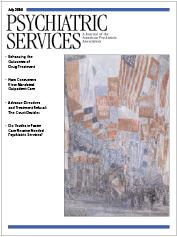Patients' and Staff's Perceptions of the Psychiatric Ward Environment
Abstract
OBJECTIVE: This study examined the extent to which patients' and staff's perceptions of the psychiatric ward atmosphere and the working conditions of staff influence patient and staff satisfaction. METHODS: A total of 640 staff members on 42 wards completed the Ward Atmosphere Scale (WAS) and the Working Environment Scale-10 (WES-10). A total of 424 patients on the same wards completed the WAS. Both patients and staff members answered three questions about their general satisfaction with the ward. The ward means were used as the unit of analysis. RESULTS: The staff members had significantly higher scores than the patients on nine of the 11 WAS subscales. Patients' and staff's WAS scores were moderately correlated. No significant correlation was found between patients' and staff's scores on the three satisfaction items. Patient satisfaction was strongly correlated with patients' WAS scores and was moderately correlated with staff's WAS scores but was not significantly correlated with staff's WES-10 scores. Staff satisfaction was moderately correlated with staff's WAS and WES-10 scores but was not correlated with patients' WAS scores. CONCLUSIONS: Different aspects of the treatment climate seem to be important for patient and staff satisfaction. The ward atmosphere seems to be more important for patient satisfaction than for staff satisfaction. The working environment is strongly related to staff satisfaction but seems to be unrelated to patient satisfaction.



